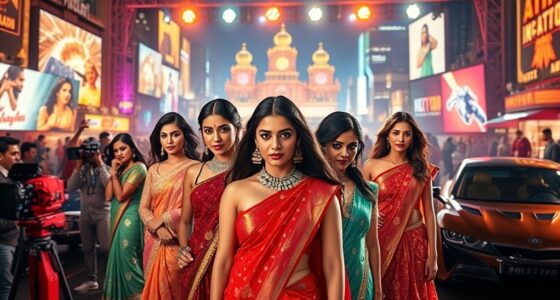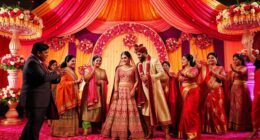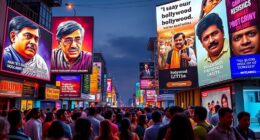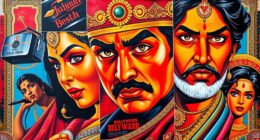You’ve likely noticed how Bollywood costumes have shifted from traditional, regal outfits that showcase India’s rich history to more modern and experimental styles. Designers blend heritage with contemporary trends, creating looks that influence everything from everyday fashion to high couture. Costumes tell stories of eras gone by while pushing fashion forward. If you want to explore how these styles evolved and shaped industry trends, there’s plenty more to uncover.
Key Takeaways
- Bollywood costumes evolved from traditional, regal attire inspired by India’s cultural history to modern, experimental styles blending heritage with contemporary fashion.
- Classic films like *Mughal-e-Azam* set standards for opulent embroidery and jewelry, influencing subsequent costume design trends.
- Costume designers incorporate historical elements into modern silhouettes, reflecting shifting cultural influences and technological advancements.
- On-screen fashion trends, such as lehengas and sarees, frequently influence streetwear and high fashion, demonstrating cinema’s cyclical impact.
- The ongoing fusion of vintage-inspired and innovative costumes showcases Bollywood’s role in shaping evolving industry aesthetics.

Fashion in films has long served as a powerful tool to define characters, set moods, and influence trends. When you watch Bollywood movies, you can’t help but notice how costumes do more than just dress the characters—they tell stories, reflect eras, and inspire entire fashion movements. Over the decades, Bollywood costumes have evolved dramatically, blending traditional elements with contemporary styles. This evolution is deeply rooted in historical costume influences, which serve as a foundation for modern fashion trends today.
Bollywood costumes blend tradition and modernity, shaping trends and telling stories through evolving fashion inspired by history.
In the early days of Indian cinema, costumes drew heavily from historical and cultural sources. Think of the regal attire in period dramas or the traditional sarees and dhotis worn by actors to evoke authenticity. These choices weren’t just about aesthetics; they paid homage to India’s rich heritage and helped establish a sense of identity on screen. As Bollywood grew, costume designers began to incorporate elements from India’s past to create a sense of grandeur and nostalgia, which still influences fashion today. For instance, the use of intricate embroidery, jewelry, and fabrics in classic films like Mughal-e-Azam set a standard for opulence that continues to inspire modern designers.
Fast forward to the modern era, and you’ll see how Bollywood costumes have become more experimental, mixing traditional influences with global fashion trends. The shift is evident in how contemporary actors wear designer ensembles that combine traditional motifs with sleek, modern silhouettes. This fusion not only reflects changing cultural dynamics but also influences everyday fashion. You might notice how the popularity of lehengas, sarees, or kurtas with modern cuts and embellishments in films sparks new trends among young audiences. The influence of cinema on fashion is cyclical: what you see on the big screen often filters into streetwear and high fashion.
As Bollywood continues to evolve, costume designers play a essential role in shaping the industry’s aesthetic. They draw inspiration from historical costumes but adapt them to appeal to today’s fashion sensibilities. This ongoing dialogue between the past and present creates a visual language that resonates with diverse audiences. Whether it’s a vintage-inspired look or a cutting-edge ensemble, Bollywood costumes reflect a seamless blend of history and modernity. You, as a viewer, are constantly exposed to this visual storytelling, which influences your personal style and perceptions of fashion. In addition, the use of textured fabrics and innovative design techniques further enhances the visual appeal of costumes and keeps the industry at the forefront of fashion innovation. This way, Bollywood costumes remain a dynamic force—rooted in history yet always pushing forward into new fashion trends.
Frequently Asked Questions
How Have Bollywood Costume Designers Influenced Global Fashion Trends?
You see how Bollywood costume designers influence global fashion trends by showcasing vibrant, innovative styles that often make their way onto the red carpet and international runways. Their bold choices, blending traditional and modern elements, inspire designers worldwide. As you follow these trends, you’ll notice Bollywood’s impact, from glamorous sarees to statement accessories, shaping global fashion and encouraging cross-cultural exchanges in style.
What Role Do Costumes Play in Character Development?
Costumes play a essential role in character development, helping you express personality and highlight emotional states. Studies show that 75% of viewers notice wardrobe choices, making costumes a powerful storytelling tool. They visually communicate a character’s traits, mood, and background, allowing you to understand and connect with them on a deeper level. By carefully selecting outfits, costume designers enhance the narrative, making characters more authentic and memorable.
How Do Costumes Reflect Regional and Cultural Diversity in Bollywood Films?
You see costumes in Bollywood films vividly reflect regional attire and cultural symbolism, showcasing India’s diversity. When you watch characters in traditional sarees, dhotis, or turbans, you recognize their regional roots and cultural backgrounds. These costumes aren’t just clothing but serve as visual cues, celebrating local customs and traditions. They help you connect emotionally, understanding characters’ identities and regional influences through authentic, culturally rich attire.
What Are the Challenges in Maintaining Historical Accuracy in Period Costumes?
You face authenticity challenges when trying to recreate period costumes, as finding accurate fabrics and styles can be tough. Preservation dilemmas also arise, since old materials may degrade, making it hard to maintain historical integrity. Balancing visual appeal with true representation demands careful research and resourcefulness, but it is crucial to keep the costumes authentic, ensuring viewers get an accurate glimpse into the era while overcoming these practical hurdles.
How Has the Rise of Digital Media Impacted Costume Design Choices?
You’ve noticed that digital media, especially social media, influences costume design choices by shaping consumer preferences rapidly. Designers now prioritize trending styles seen online, making costumes more contemporary and appealing to audiences. This shift allows for quicker updates and more diverse looks, but it can also challenge traditional aesthetics and historical accuracy. Ultimately, social media drives a dynamic, fast-paced evolution in costume design, reflecting current trends and audience demands.
Conclusion
As you watch Bollywood’s cinematic tapestry unfold, you can see fashion weave vibrant threads through time, turning each costume into a brushstroke on a living canvas. The evolution of these styles paints a story of culture, passion, and innovation, shimmering like a kaleidoscope of colors and textures. So, next time you see a film, remember that behind every look lies a story of change—fashion’s dance through history, forever shaping the glamour of Bollywood’s grand stage.









